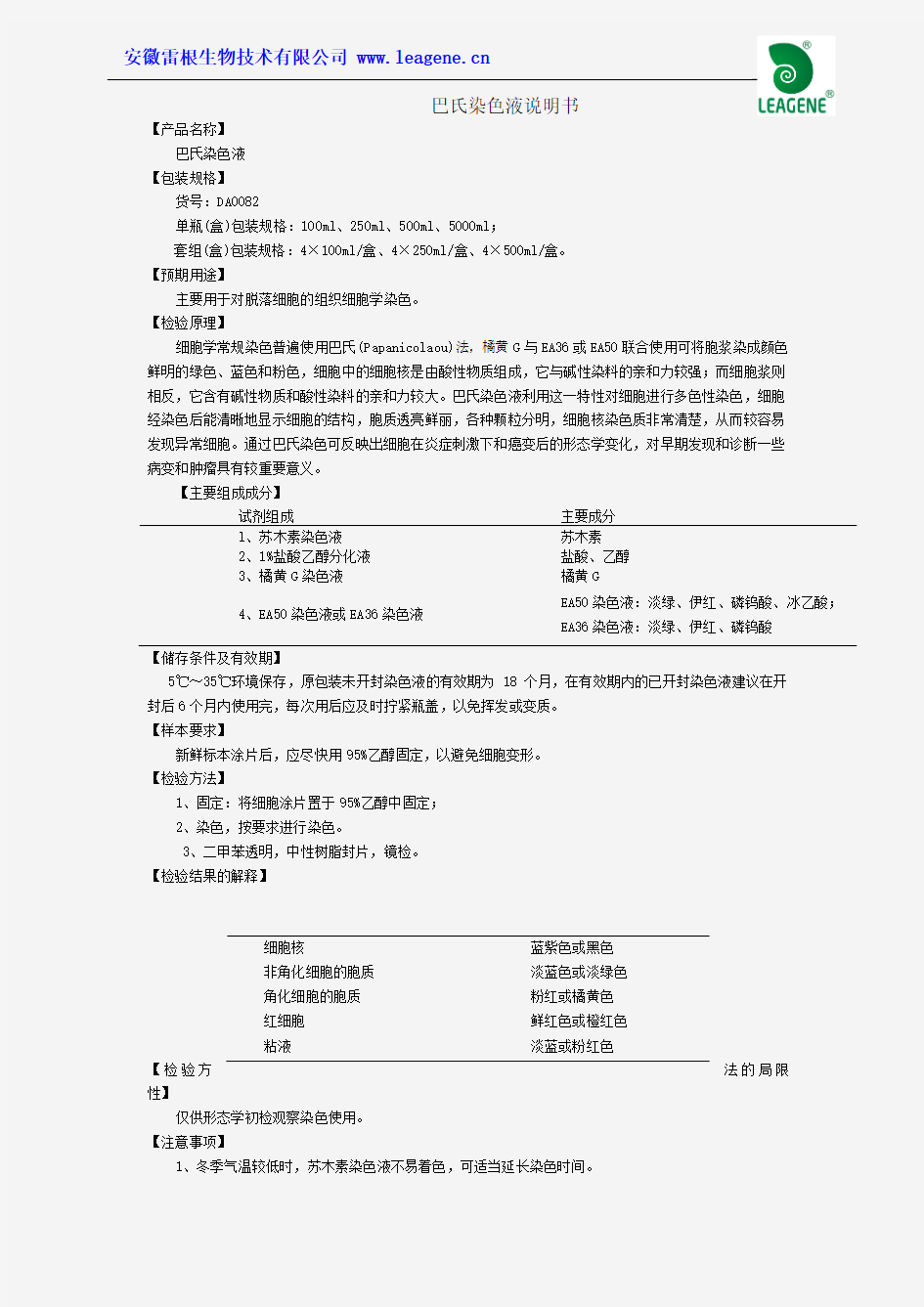改良巴氏染液


巴氏染色液说明书
【产品名称】 巴氏染色液 【包装规格】
货号:DA0082
单瓶(盒)包装规格:100ml 、250ml 、500ml 、5000ml ;
套组(盒)包装规格:4×100ml/盒、4×250ml/盒、4×500ml/盒。 【预期用途】
主要用于对脱落细胞的组织细胞学染色。 【检验原理】
细胞学常规染色普遍使用巴氏(Papanicolaou)法,橘黄G 与EA36或EA50联合使用可将胞浆染成颜色鲜明的绿色、蓝色和粉色,细胞中的细胞核是由酸性物质组成,它与碱性染料的亲和力较强;而细胞浆则相反,它含有碱性物质和酸性染料的亲和力较大。巴氏染色液利用这一特性对细胞进行多色性染色,细胞经染色后能清晰地显示细胞的结构,胞质透亮鲜丽,各种颗粒分明,细胞核染色质非常清楚,从而较容易发现异常细胞。通过巴氏染色可反映出细胞在炎症刺激下和癌变后的形态学变化,对早期发现和诊断一些病变和肿瘤具有较重要意义。 【主要组成成分】
试剂组成
主要成分 l 、苏木素染色液
苏木素 2、1%盐酸乙醇分化液 盐酸、乙醇 3、橘黄G 染色液
橘黄G
4、EA50染色液或EA36染色液
EA50染色液:淡绿、伊红、磷钨酸、冰乙酸; EA36染色液:淡绿、伊红、磷钨酸
【储存条件及有效期】
5℃~35℃环境保存,原包装未开封染色液的有效期为18个月,在有效期内的已开封染色液建议在开封后6个月内使用完,每次用后应及时拧紧瓶盖,以免挥发或变质。 【样本要求】
新鲜标本涂片后,应尽快用95%乙醇固定,以避免细胞变形。 【检验方法】
1、固定:将细胞涂片置于95%乙醇中固定;
2、染色,按要求进行染色。
3、二甲苯透明,中性树脂封片,镜检。 【检验结果的解释】
【检验方法的局限
性】
仅供形态学初检观察染色使用。 【注意事项】
1、冬季气温较低时,苏木素染色液不易着色,可适当延长染色时间。
细胞核
蓝紫色或黑色 非角化细胞的胞质 淡蓝色或淡绿色 角化细胞的胞质 粉红或橘黄色 红细胞 鲜红色或橙红色 粘液
淡蓝或粉红色
2、橘黄G染色液染色时间不宜过长,且在乙醇中要尽量洗净多余的染色液,否则会影响EA50染色液或EA36染色液的着色。
3、请不要将新旧批号的EA50染色液或EA36染色液混合使用。
4、该试剂盒贮存时,尽量避免高温及光亮环境以免影响品质和效果
5、本产品仅用于体外诊断,应由专业人士使用及进行结果的判读。
6、使用前应详细阅读说明书,并做好个人卫生防护,在有效期内使用,生产日期、生产批号和失效日期见包装。
7、用后应按医院或环保部门要求处置废弃物。
【基本信息】
备案人/生产企业名称:安徽雷根生物技术有限公司
住所:淮北凤凰山经济开发区凤冠路三期标准化厂房三号厂房
巴氏指数评分表barthel_index
Date created: 1/2000 Last reviewed: 8/2004 Reviewed/Approved by: L. Schwamm, M.D. / Acute Stroke Team Barthel Index Scoring Form Patient Name: _____________________ Rater Name:_____________________ Date:____________ FEEDING 0 = unable 5 = needs help cutting, spreading butter, etc., or requires modified diet 10 = independent BATHING 0 = dependent 5 = independent (or in shower) GROOMING 0 = needs to help with personal care 5 = independent face/hair/teeth/shaving (implements provided) DRESSING 0 = dependent 5 = needs help but can do about half unaided 10 = independent (including buttons, zips, laces, etc.) BOWELS 0 = incontinent (or needs to be given enemas) 5 = occasional accident 10 = continent BLADDER 0 = incontinent, or catheterized and unable to manage alone 5 = occasional accident 10 = continent TOILET USE 0 = dependent 5 = needs some help, but can do something alone 10 = independent (on and off, dressing, wiping) TRANSFERS (BED TO CHAIR AND BACK) 0 = unable, no sitting balance 5 = major help (one or two people, physical), can sit 10 = minor help (verbal or physical) 15 = independent MOBILITY (ON LEVEL SURFACES) 0 = immobile or < 50 yards 5 = wheelchair independent, including corners, > 50 yards 10 = walks with help of one person (verbal or physical) > 50 yards 15 = independent (but may use any aid; for example, stick) > 50 yards STAIRS 0 = unable 5 = needs help (verbal, physical, carrying aid) 10 = independent TOTAL SCORE = _____________ The Barthel ADL Index: Guidelines 1. The index should be used as a record of what a patient does, not as a record of what a patient could do. 2. The main aim is to establish degree of independence from any help, physical or verbal, however minor and for whatever reason. 3. The need for supervision renders the patient not independent. 4. A patient's performance should be established using the best available evidence. Asking the patient, friends/relatives and nurses are the usual sources, but direct observation and common sense are also important. However direct testing is not needed. 5. Usually the patient's performance over the preceding 24-48 hours is important, but occasionally longer periods will be relevant. 6. Middle categories imply that the patient supplies over 50 per cent of the effort. 7. Use of aids to be independent is allowed. References Mahoney FI, Barthel D. "Functional evaluation: the Barthel Index." Maryland State Medical Journal 1965;14:56-61. Used with permission. Loewen SC, Anderson BA. "Predictors of stroke outcome using objective measurement scales." Stroke.1990;21:78-81. Gresham GE, Phillips TF, Labi ML. "ADL status in stroke: relative merits of three standard indexes." Arch Phys Med Rehabil.1980;61:355-358. Collin C, Wade DT, Davies S, Horne V. "The Barthel ADL Index: a reliability study." Int Disability Study.1988;10:61-63.
改良巴氏指数评定表
改良巴氏指数评定表 ----------------------------------------------------------------------------- 项目评分标准月日 ----------------------------------------------------------------------------- 1. 大便 0=失禁或昏迷 5=偶尔失禁(每周<1次) 10=能控制 ----------------------------------------------------------------------------- 2. 小便 0=失禁或昏迷或需由他人导尿 5=偶尔失禁(每24小时<1次,每周>1次) 10=能控制 ----------------------------------------------------------------------------- 3. 修饰 0=需帮助 5=独立洗脸、梳头、刷牙、剃须 ----------------------------------------------------------------------------- 4. 用厕 0=依赖别人 5=需部分帮助 10=自理 ----------------------------------------------------------------------------- 5. 吃饭 0=依赖别人 5=需部分帮助(夹饭、盛饭、切面包) 10=全面自理 ----------------------------------------------------------------------------- 6. 转移 0=完全依赖别人,不能坐 (床←→椅) 5=需大量帮助(2人)能坐 10=需少量帮助(1人)或指导 15=自理 ----------------------------------------------------------------------------- 7. 活动(步行) 0=不能步行 (在病房及其周围, 5=在轮椅上独立行动 不包括走远路) 10=需1人帮助步行(体力或语言指导) 15=独立步行(可用辅助器) ----------------------------------------------------------------------------- 8. 穿衣 0=依赖 5=需一半帮助 10=自理(系、开钮扣、关、开拉锁和穿鞋)----------------------------------------------------------------------------- 9. 上楼梯 0=不能 (上下一段楼梯, 5=需帮助(体力或语言指导) 用手杖也算独立) 10=自理 ----------------------------------------------------------------------------- 10. 洗澡 0=依赖 5=自理
巴氏指数
康复评定 康复评定是康复治疗的基础,是康复工作者的利剑之一。没有评定就无法规划治疗和评价治疗效果。康复评定与临床医学的疾病诊断相类似,但又有其自身的专业特点。康复评定不是确定疾病的性质和类型,而是客观地、准确地评定功能障碍的性质、部位、范围、程度,预 后和转归,为康复治疗计划打下科学基础。 改良巴氏指数评定表 ----------------------------------------------------------------------------- 项目评分标准月日 ----------------------------------------------------------------------------- 1. 大便 0=失禁或昏迷 5=偶尔失禁(每周<1次) 10=能控制 ----------------------------------------------------------------------------- 2. 小便 0=失禁或昏迷或需由他人导尿 5=偶尔失禁(每24小时<1次,每周>1次) 10=能控制 ----------------------------------------------------------------------------- 3. 修饰 0=需帮助 5=独立洗脸、梳头、刷牙、剃须 ----------------------------------------------------------------------------- 4. 用厕 0=依赖别人 5=需部分帮助 10=自理 ----------------------------------------------------------------------------- 5. 吃饭 0=依赖别人 5=需部分帮助(夹饭、盛饭、切面包) 10=全面自理 ----------------------------------------------------------------------------- 6. 转移 0=完全依赖别人,不能坐 (床←→椅) 5=需大量帮助(2人)能坐 10=需少量帮助(1人)或指导 15=自理 ----------------------------------------------------------------------------- 7. 活动(步行) 0=不能步行 (在病房及其周围, 5=在轮椅上独立行动 不包括走远路)10=需1人帮助步行(体力或语言指导) 15=独立步行(可用辅助器) ----------------------------------------------------------------------------- 8. 穿衣 0=依赖
